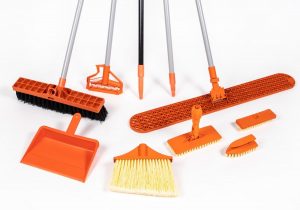Why Briarwood Cleaning Tools Are Essential To Have In Correctional Facilities
Briarwood Products has designed this specialized product line to increase the overall safety and security within Correctional Facilities. The line was developed by Briarwood Products in response to widespread safety concerns from correctional officers.

Safety Managers previously began replacing metal tools (used by inmates to make “shanks”) with hard plastic cleaning tools. They discovered that creative inmates were sharpening the hard plastic and hand-crafting the plastic into weapons and shanks. Briarwood Products specialized cleaning tools are made from a rubbery plastic that eliminates an inmates ability to create shanks. The unique polymer used cannot be sharpened like standard hard plastics, and inmates are unable to form or re-form the plastic into a weapon or shank.
Through our extensive research of the study Improving Correctional Officer Safety: Reducing Inmate Weapons performed by Johns Hopkins Centre for Injury Research Laboratory, we have engineered the Shank-Free and Metal Free product line. The research report states, “The shank takes the place of the gun on the streets” and our objective is to eliminate the ability to do so. The findings from this study showed the most common threat faced by officers and guards in correctional facilities today is from pointed and sharp edged weapons. Our unique design uses a special rubbery plastic that will virtually eliminate the creation of shanks. The unique polymer that is used disables the inmate’s ability to form or reform plastic into a shank or shank handle.
Below is Data of Fatal and Non Fatal injuries within Correctional Facilities:
Work-related fatalities:
-
There were 113 correctional officer fatalities reported — the fatality rate was 2.7 per 100,000 FTEs (CI = ± 0.8);
-
On average, 11 work-related fatalities were reported per year;
-
Male correctional officers incurred the majority of fatalities and more than two-thirds occurred to officers ages 45 and older;
-
Assaults, violent acts and transportation-related fatalities accounted for 80 percent of all fatalities;
-
Among fatal assaults and violent acts, 62 percent were due to homicides and 38 percent were due to suicides by self-inflicted gunshot wounds; and
-
Of the homicides, 65 percent were committed by inmates and the remaining were committed by coworkers, strangers or personal relations of the correctional officer.
Nonfatal work-related injuries:
-
An estimated 125,200 (CI = ± 70,100) nonfatal work-related injuries were treated in EDs for a rate of 3.0 (CI = ± 1.9) per 100 FTEs;
-
The majority of nonfatal injuries occurred to male correctional officers;
-
Half of the nonfatal injuries were among officers ages 35 years and older;
-
The majority of injuries were due to assaults and violent acts, followed by overexertion, and contact with dangerous objects and equipment;
-
Of the nonfatal assaults and violent act injuries, more than one-third (37 percent) occurred while restraining an inmate or interacting with an inmate during an altercation;
-
Nonfatal injuries primarily affected the upper limb, with approximately two-thirds affecting the hand and fingers; and
-
The most common types of work-related nonfatal injuries were sprains and strains (30 percent), followed by contusions and abrasions (28 percent).[Bureau of Labor Statistics. Census of fatal occupational injuries. 2012 Retrieved fromhttp://www.bls.gov/iif/oshfat1.htm.Jackson L. Non-fatal occupational injuries and illnesses treated in hospital emergency departments in the United States. Injury Prevention. 2001;7(1):i21–i26. [PMC free article] [PubMed] Konda S, Reichard A, Tiesman H. Occupational injuries among U.S. correctional officers, 1999–2008. Journal of Safety Research. 2012;43:181–186. [PMC free article] [PubMed]]
Plastic 56″ Flexible Handle
Along with the orange Shank-Free cleaning tools, Briarwood has also designed the new Plastic Handle. Unlike other standard handles, the Plastic handle is flexible and has the ability to bend side to side easily without breaking. The flexibility of this handle is an added safety feature disabling it to be used as a club or stick.


